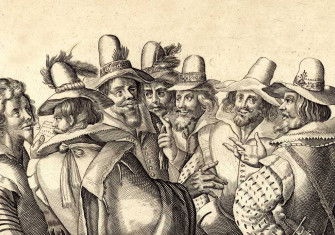Broad Church
Soaring and swooping through a history of Catholicism, from 1789 to the present day.

Catholicism unites the pope in Rome with the priest in the Amazon, the persecuted layperson in China with the current president of the United States. The religion is led by the most diverse institution in the world, spanning the radical to the reactionary.
John McGreevy’s Catholicism: A Global History does justice to the vast scope and influence of this multicultural and multilingual creed. He begins with the French Revolution, a process widely lamented in Catholic collective memory. But, as McGreevy describes, reform-minded clergy at the time believed that, for all its iconoclasm and anticlericalism, the first phase of the Revolution was ‘based on the Gospels’. One priest, who chaired the assembly that voted to execute Louis XVI, wrote that ‘Christianity is the friend of the Republic [and] the friend of liberty, equality and fraternity’.
The fissure between reformers and conservatives is the key thread in McGreevy’s book. Over the course of the 19th century, the reformist current was met by an arch conservative movement known as ultramontanism, which emphasised the authority of the pope and of the Church hierarchy. Many principles of ultramontanism, such as the belief in papal infallibility, became official dogma in 1869, when bishops gathered for the pre-eminent ecclesiastical summit of the century: the First Vatican Council.
Ultramontanism may have won the initial doctrinal battle, but reformist Catholicism developed in political and social spheres during the 19th century, tied to anticolonialism and democratic republicanism. McGreevy writes: ‘Irish Catholics defending themselves from British overlords, Polish Catholics mistrustful of Russian tsars, Mexican Catholics loyal to Our Lady of Guadalupe, and Croatian Catholics struggling for distance from Habsburg rulers all saw Catholicism as interwoven with the destiny of a particular people.’
Reformist Catholic sentiment endured in the 20th century, despite the Vatican’s concordats with fascist Italy and Germany. It came particularly to the fore in the period of Asian and African decolonisation that followed the Second World War. Vietnamese bishops, for example, called loudly for independence from France; Senegal’s first president, Léopold Senghor, believed full independence required native leadership of its Church.
By the time Pope John XXIII convened the Second Vatican Council (1962-65) with the aim of modernising the Church and reforming the most traditionalist elements of the previous Council, the hierarchy of Catholicism was global. McGreevy explains that, whereas the first Vatican Council had been a Eurocentric affair, the second was much more influenced by bishops from the Global South. Infused with reformist sentiment, the Council approved the use of vernacular languages at the Mass, established a greater role in the Church for lay people and encouraged ecumenical dialogue. McGreevy calls the Council ‘one of the most important events of the twentieth century’ and ‘the hinge point in how Catholics got from the French Revolution to the current moment’. Perhaps the most significant development was the notion that, rather than remain distant from modern, secular society, the Church would strive to engage with the non-Catholic world.
Not all Catholics agreed and the Council’s most extreme critics formed splinter organisations such as the ultra-traditionalist Society of Saint Pius X, which has come into regular conflict with the Vatican. The papacy of the late Benedict XVI was often caught between preserving the teaching of the council and allowing religious freedom to conservatives. The election of Benedict’s successor, Pope Francis – a reformer and the first non-European pontiff since 741 – was in many ways an endorsement of the spirit of the Second Vatican Council.
Still, the reforms have not been enough to prevent a steady reduction in the number of practising Catholics, especially in Europe. In 2020, the Church in Ireland, which, as McGreevy notes, was ‘once the source of missionary clergy and nuns for much of the Anglophone world’, ordained only one priest. In France, of those who identify as Catholic, only one in ten go to Mass on a weekly basis. There are explanations aplenty, but the decline is a continuation of the secularising process that began at the time of the French Revolution.
McGreevy’s book explores Catholicism by soaring and swooping. At its best, it covers vast ground with disciplined concision. Sometimes, however, the pace is so quick that the story resembles a listicle. Such is the price of writing an accessible global history of such a multifaceted creed.
Catholicism: A Global History from the French Revolution to Pope Francis
John T. McGreevy
W.W. Norton 528pp £25.99
Buy from bookshop.org (affiliate link)
Daniel Rey is a writer and critic based in New York.






